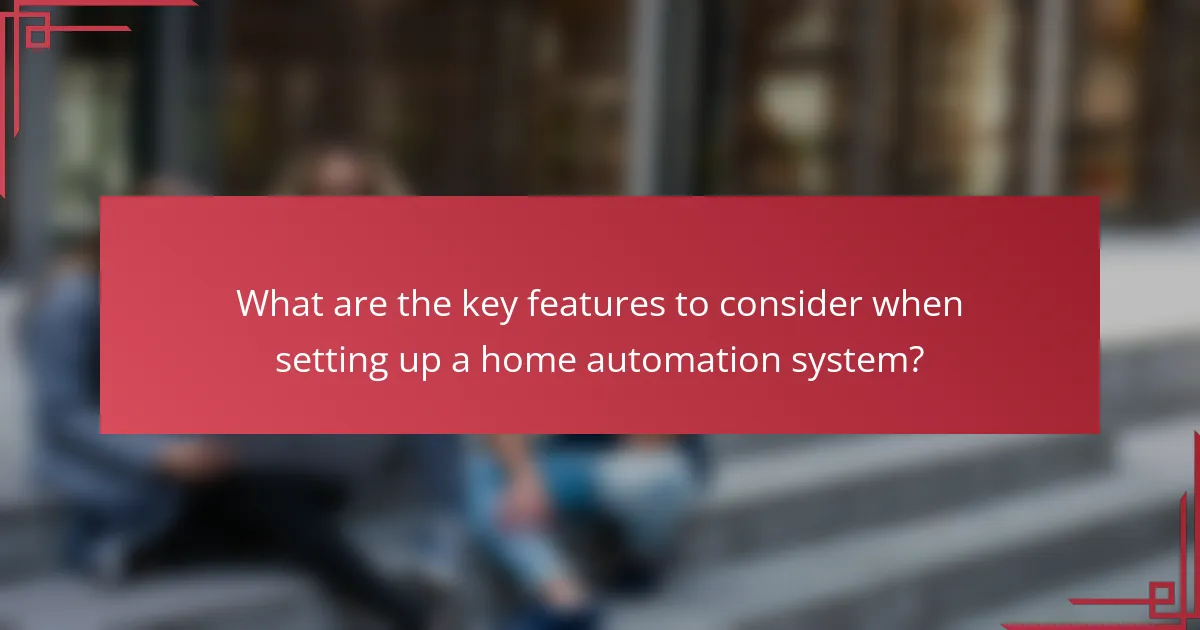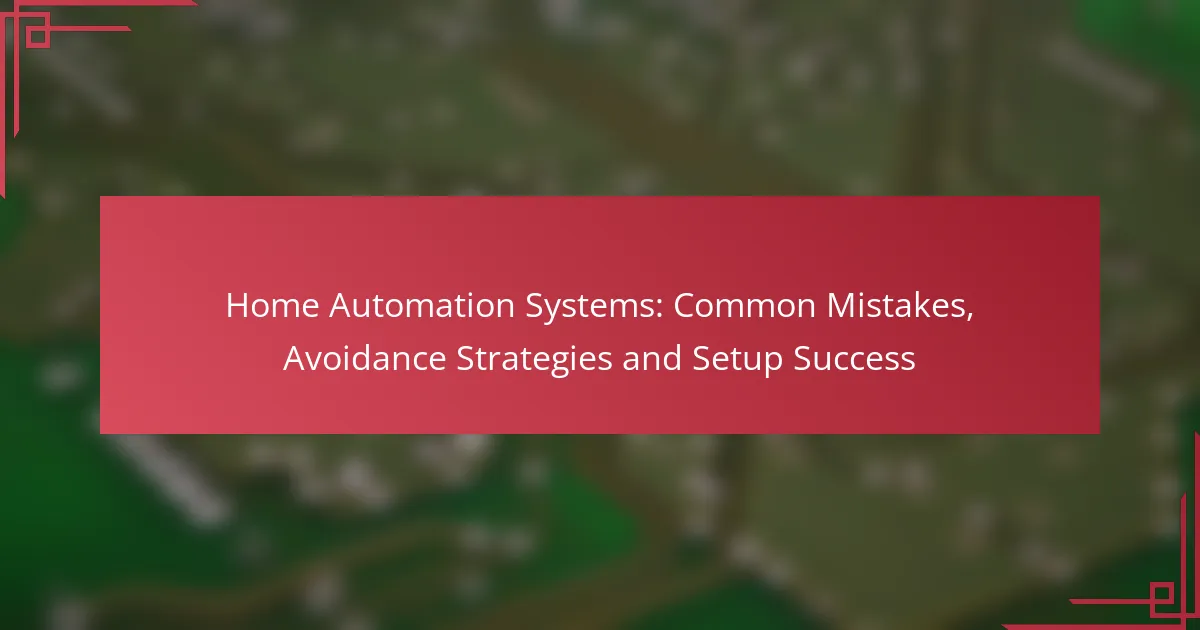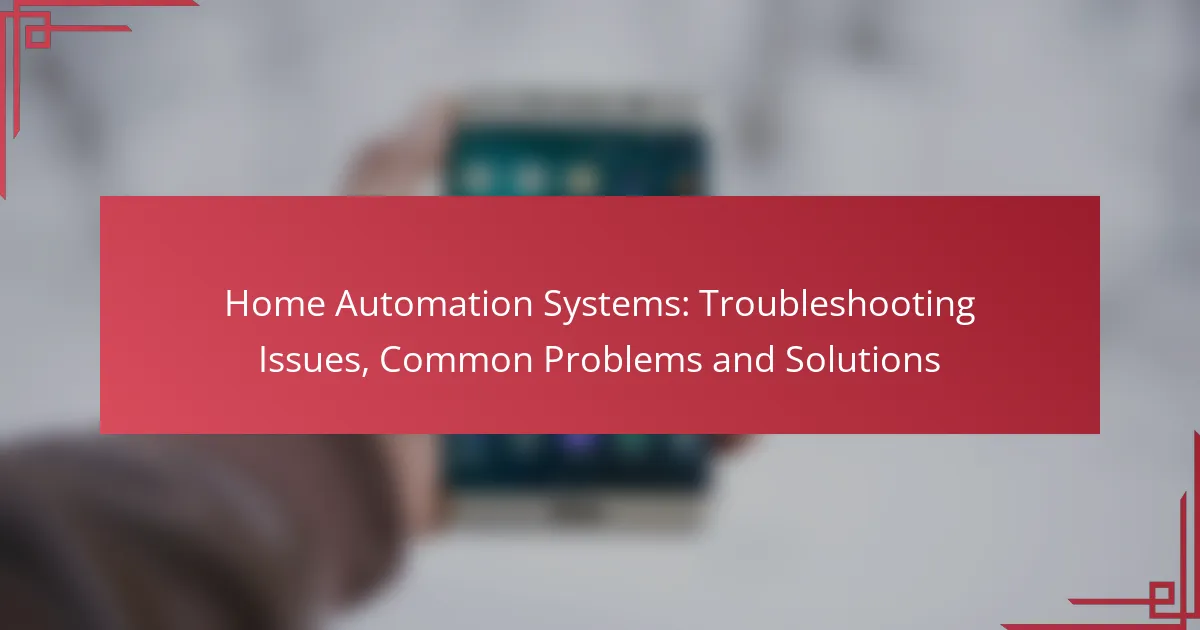Home automation systems can greatly enhance convenience and efficiency in your daily life, but common mistakes can hinder their effectiveness. Issues such as device compatibility, complex setups, and security risks often arise, making it essential to plan and research thoroughly before implementation. By understanding these pitfalls and focusing on proper setup, you can create a seamless and successful home automation experience.

What are common mistakes in home automation systems?
Common mistakes in home automation systems include issues like device compatibility, overly complex setups, security risks, inadequate user training, and selecting the wrong platform. Avoiding these pitfalls is crucial for achieving a seamless and effective home automation experience.
Lack of compatibility with existing devices
One of the most frequent mistakes is failing to ensure that new automation devices are compatible with existing systems. Before purchasing, check if the devices can communicate with each other through common protocols like Zigbee or Z-Wave.
To avoid compatibility issues, create a list of your current devices and verify their specifications against potential new purchases. This will help you make informed decisions and prevent costly returns.
Overcomplicating the setup process
Many users complicate their home automation setups by integrating too many devices at once or choosing overly complex configurations. Start with a few essential devices that serve your primary needs, such as smart lighting or a thermostat, and expand gradually.
Consider using user-friendly platforms that offer guided setup processes. This can simplify installation and reduce frustration, allowing you to enjoy automation benefits without overwhelming yourself.
Ignoring security vulnerabilities
Security is often overlooked in home automation, making systems vulnerable to hacking. Ensure that all devices are updated with the latest firmware and use strong, unique passwords for each device.
Implementing a network security protocol, such as WPA3 for Wi-Fi, can significantly enhance your system’s defenses. Regularly review your security settings to adapt to new threats and maintain a secure environment.
Neglecting user training
Failing to train users on how to operate home automation systems can lead to frustration and underutilization. Provide clear instructions and resources for all household members to ensure they understand how to use the technology effectively.
Consider creating a simple user manual or hosting a training session to demonstrate features and functionalities. This will empower users and enhance their experience with the system.
Choosing the wrong platform
Selecting an unsuitable home automation platform can limit functionality and compatibility. Research various platforms to find one that aligns with your needs and supports the devices you plan to use.
Look for platforms that offer flexibility, scalability, and strong community support. Reading user reviews and comparing features can help you make a more informed choice, ensuring long-term satisfaction with your automation system.

How can you avoid mistakes in home automation?
To avoid mistakes in home automation, focus on thorough planning and research before implementation. Understanding compatibility, installation processes, security, and user support can significantly enhance your setup’s success.
Research compatible devices
Before purchasing any home automation devices, ensure they are compatible with your existing systems and each other. Check for interoperability standards like Z-Wave, Zigbee, or Wi-Fi, as these can affect how well devices communicate.
Consider reading reviews and user experiences to identify potential issues with specific devices. A well-researched selection can save you time and money in the long run.
Simplify the installation process
Streamlining the installation process can prevent common mistakes. Opt for devices that offer straightforward setup procedures, ideally with mobile app support that guides you step-by-step.
Consider hiring a professional if the installation seems complex or if you lack the technical expertise. This investment can ensure that your system is set up correctly and functions as intended.
Implement strong security measures
Security is crucial in home automation to protect your personal data and devices. Use strong, unique passwords for each device and enable two-factor authentication where available.
Regularly update device firmware to patch vulnerabilities and consider using a separate network for your smart devices to minimize risks. This layered approach enhances your overall security posture.
Provide user training and support
Training users on how to operate the home automation system can prevent misuse and frustration. Create simple guides or tutorials that cover basic functions and troubleshooting steps.
Establish a support system, whether through a dedicated contact person or online resources, to assist users with any issues they may encounter. This proactive approach can enhance user satisfaction and system efficiency.
Select a reliable automation platform
Choosing a dependable automation platform is vital for seamless integration and control of your devices. Look for platforms that support a wide range of devices and offer robust customer support.
Evaluate platforms based on user reviews, ease of use, and the availability of updates. A reliable platform will not only enhance functionality but also ensure long-term viability for your home automation system.

What are the best home automation systems in Ireland?
The best home automation systems in Ireland include Google Nest, Amazon Alexa, Apple HomeKit, Samsung SmartThings, and Philips Hue. These systems offer various features such as voice control, smart device integration, and user-friendly interfaces, making them suitable for different home automation needs.
Google Nest
Google Nest is a versatile home automation system that integrates seamlessly with various smart devices. It allows users to control lighting, thermostats, and security systems through voice commands or the Google Home app.
One of its key advantages is the ability to create routines, enabling multiple devices to work together at specific times or under certain conditions. For example, you can set a routine to turn off lights and lower the thermostat when you leave home.
Amazon Alexa
Amazon Alexa is a popular choice for home automation, offering compatibility with thousands of smart devices. Users can control their home environment using voice commands through Echo devices or the Alexa app.
Alexa’s skills allow for extensive customization, enabling users to set up smart home routines, control music, and even order products online. Consider starting with a few essential devices to build your system gradually.
Apple HomeKit
Apple HomeKit is ideal for users within the Apple ecosystem, providing a secure and user-friendly way to manage smart devices. It allows for automation through the Home app on iOS devices, enabling control over compatible devices with Siri.
HomeKit emphasizes privacy and security, making it a great choice for users concerned about data protection. However, it may have fewer compatible devices compared to other systems, so check compatibility before investing.
Samsung SmartThings
Samsung SmartThings is a comprehensive home automation platform that supports a wide range of devices from various manufacturers. It offers a centralized hub for managing smart devices, allowing for easy integration and control.
SmartThings features automation capabilities, enabling users to create custom routines based on triggers like time of day or device status. Its flexibility makes it suitable for both beginners and advanced users looking to expand their smart home setup.
Philips Hue
Philips Hue specializes in smart lighting, offering a variety of bulbs and fixtures that can be controlled via the Hue app or voice commands. Users can create personalized lighting scenes and schedules to enhance their home environment.
While primarily focused on lighting, Philips Hue can integrate with other smart home systems, allowing for broader automation. Consider starting with a starter kit to explore the benefits of smart lighting in your home.

What are the key features to consider when setting up a home automation system?
When setting up a home automation system, key features to consider include device compatibility, user interface, security, and scalability. These elements ensure that the system operates smoothly, is easy to manage, and can grow with your needs.
Device compatibility
Device compatibility is crucial for a successful home automation system. Ensure that the devices you choose can communicate with each other, typically through common protocols like Zigbee, Z-Wave, or Wi-Fi. This compatibility allows for seamless integration and control from a single platform.
Before purchasing devices, check their compatibility with your chosen hub or controller. For instance, if you opt for a smart home hub, verify that it supports the brands and types of devices you plan to use, such as smart lights, thermostats, and security cameras.
Avoid the pitfall of mixing too many brands or protocols, as this can lead to connectivity issues. Stick to a few trusted brands that offer a wide range of compatible devices to simplify your setup and maintenance.



